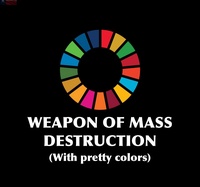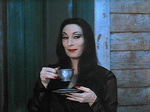Moderna umjetnost je bilo oružje CIA-e
Page 1 of 1
 Moderna umjetnost je bilo oružje CIA-e
Moderna umjetnost je bilo oružje CIA-e
http://www.independent.co.uk/news/world/modern-art-was-cia-weapon-1578808.html

Kermit-

Posts : 26479
2014-04-17
 Re: Moderna umjetnost je bilo oružje CIA-e
Re: Moderna umjetnost je bilo oružje CIA-e
For decades in art circles it was either a rumour or a joke, but now it is confirmed as a fact. The Central Intelligence Agency used American modern art - including the works of such artists as Jackson Pollock, Robert Motherwell, Willem de Kooning and Mark Rothko - as a weapon in the Cold War. In the manner of a Renaissance prince - except that it acted secretly - the CIA fostered and promoted American Abstract Expressionist painting around the world for more than 20 years.
The connection is improbable. This was a period, in the 1950s and 1960s, when the great majority of Americans disliked or even despised modern art - President Truman summed up the popular view when he said: "If that's art, then I'm a Hottentot." As for the artists themselves, many were ex- communists barely acceptable in the America of the McCarthyite era, and certainly not the sort of people normally likely to receive US government backing.
Why did the CIA support them? Because in the propaganda war with the Soviet Union, this new artistic movement could be held up as proof of the creativity, the intellectual freedom, and the cultural power of the US. Russian art, strapped into the communist ideological straitjacket, could not compete.
The existence of this policy, rumoured and disputed for many years, has now been confirmed for the first time by former CIA officials. Unknown to the artists, the new American art was secretly promoted under a policy known as the "long leash" - arrangements similar in some ways to the indirect CIA backing of the journal Encounter, edited by Stephen Spender.
The decision to include culture and art in the US Cold War arsenal was taken as soon as the CIA was founded in 1947. Dismayed at the appeal communism still had for many intellectuals and artists in the West, the new agency set up a division, the Propaganda Assets Inventory, which at its peak could influence more than 800 newspapers, magazines and public information organisations. They joked that it was like a Wurlitzer jukebox: when the CIA pushed a button it could hear whatever tune it wanted playing across the world.
The next key step came in 1950, when the International Organisations Division (IOD) was set up under Tom Braden. It was this office which subsidised the animated version of George Orwell's Animal Farm, which sponsored American jazz artists, opera recitals, the Boston Symphony Orchestra's international touring programme. Its agents were placed in the film industry, in publishing houses, even as travel writers for the celebrated Fodor guides. And, we now know, it promoted America's anarchic avant-garde movement, Abstract Expressionism.
Initially, more open attempts were made to support the new American art. In 1947 the State Department organised and paid for a touring international exhibition entitled "Advancing American Art", with the aim of rebutting Soviet suggestions that America was a cultural desert. But the show caused outrage at home, prompting Truman to make his Hottentot remark and one bitter congressman to declare: "I am just a dumb American who pays taxes for this kind of trash." The tour had to be cancelled.
The US government now faced a dilemma. This philistinism, combined with Joseph McCarthy's hysterical denunciations of all that was avant-garde or unorthodox, was deeply embarrassing. It discredited the idea that America was a sophisticated, culturally rich democracy. It also prevented the US government from consolidating the shift in cultural supremacy from Paris to New York since the 1930s. To resolve this dilemma, the CIA was brought in.
The connection is improbable. This was a period, in the 1950s and 1960s, when the great majority of Americans disliked or even despised modern art - President Truman summed up the popular view when he said: "If that's art, then I'm a Hottentot." As for the artists themselves, many were ex- communists barely acceptable in the America of the McCarthyite era, and certainly not the sort of people normally likely to receive US government backing.
Why did the CIA support them? Because in the propaganda war with the Soviet Union, this new artistic movement could be held up as proof of the creativity, the intellectual freedom, and the cultural power of the US. Russian art, strapped into the communist ideological straitjacket, could not compete.
The existence of this policy, rumoured and disputed for many years, has now been confirmed for the first time by former CIA officials. Unknown to the artists, the new American art was secretly promoted under a policy known as the "long leash" - arrangements similar in some ways to the indirect CIA backing of the journal Encounter, edited by Stephen Spender.
The decision to include culture and art in the US Cold War arsenal was taken as soon as the CIA was founded in 1947. Dismayed at the appeal communism still had for many intellectuals and artists in the West, the new agency set up a division, the Propaganda Assets Inventory, which at its peak could influence more than 800 newspapers, magazines and public information organisations. They joked that it was like a Wurlitzer jukebox: when the CIA pushed a button it could hear whatever tune it wanted playing across the world.
The next key step came in 1950, when the International Organisations Division (IOD) was set up under Tom Braden. It was this office which subsidised the animated version of George Orwell's Animal Farm, which sponsored American jazz artists, opera recitals, the Boston Symphony Orchestra's international touring programme. Its agents were placed in the film industry, in publishing houses, even as travel writers for the celebrated Fodor guides. And, we now know, it promoted America's anarchic avant-garde movement, Abstract Expressionism.
Initially, more open attempts were made to support the new American art. In 1947 the State Department organised and paid for a touring international exhibition entitled "Advancing American Art", with the aim of rebutting Soviet suggestions that America was a cultural desert. But the show caused outrage at home, prompting Truman to make his Hottentot remark and one bitter congressman to declare: "I am just a dumb American who pays taxes for this kind of trash." The tour had to be cancelled.
The US government now faced a dilemma. This philistinism, combined with Joseph McCarthy's hysterical denunciations of all that was avant-garde or unorthodox, was deeply embarrassing. It discredited the idea that America was a sophisticated, culturally rich democracy. It also prevented the US government from consolidating the shift in cultural supremacy from Paris to New York since the 1930s. To resolve this dilemma, the CIA was brought in.

Kermit-

Posts : 26479
2014-04-17
 Re: Moderna umjetnost je bilo oružje CIA-e
Re: Moderna umjetnost je bilo oružje CIA-e
već su impresionisti ukrčili put (preko sezana koji je utjecao na pjavu kubizma i sveopće slobode od klasicizma) modernoj umjetnosti.
Amerika jeste planski ulagala u kulturu jer je bila deficitarna u odnosu n mnogo
stariju rusku kulturu i opcenito europsku, ali nikako nije određivala pavac kojim je umjetnost išla. To je bla bla truć truć prica
Amerika jeste planski ulagala u kulturu jer je bila deficitarna u odnosu n mnogo
stariju rusku kulturu i opcenito europsku, ali nikako nije određivala pavac kojim je umjetnost išla. To je bla bla truć truć prica
_________________
It was always the women, and above all the young ones, who were the most bigotet adherents of the party, the swallowers of slogans, the amateur spies and nosers-out of unortodoxy.
Orwell 1984

prckov- Posts : 34555
2014-04-19
 Re: Moderna umjetnost je bilo oružje CIA-e
Re: Moderna umjetnost je bilo oružje CIA-e
vidi kako prcko zna.prckov wrote:već su impresionisti ukrčili put (preko sezana koji je utjecao na pjavu kubizma i sveopće slobode od klasicizma) modernoj umjetnosti.
Amerika jeste planski ulagala u kulturu jer je bila deficitarna u odnosu n mnogo
stariju rusku kulturu i opcenito europsku, ali nikako nije određivala pavac kojim je umjetnost išla. To je bla bla truć truć prica


frakcija- Posts : 5635
2016-03-09

Regoč-

Posts : 35954
2015-08-21
Age : 106
Lokacija: : Doma
 Similar topics
Similar topics» Moderna umjetnost kroz jednu vijest
» DOSTA JE BILO SUKOBA Karamarko: Bolje novac ulagati u privredu, nego u oružje
» Zbog Irana koji salje oruzje Rusiji,Izrael ce slati svoje oruzje Ukrajini?!
» ŠTA BI BILO KAD BI BILO Kako bi izgledala Jugoslavija ako bi se danas OBNOVILA? (VIDEO)
» Gdje god žive Srbi, to je Srbija, bilo u Srbiji, bilo u BiH, Vojvodini, Crnoj Gori ili na drugim mjestima
» DOSTA JE BILO SUKOBA Karamarko: Bolje novac ulagati u privredu, nego u oružje
» Zbog Irana koji salje oruzje Rusiji,Izrael ce slati svoje oruzje Ukrajini?!
» ŠTA BI BILO KAD BI BILO Kako bi izgledala Jugoslavija ako bi se danas OBNOVILA? (VIDEO)
» Gdje god žive Srbi, to je Srbija, bilo u Srbiji, bilo u BiH, Vojvodini, Crnoj Gori ili na drugim mjestima
Page 1 of 1
Permissions in this forum:
You cannot reply to topics in this forum
 Events
Events Latest images
Latest images
 by Kermit 25/6/2016, 03:13
by Kermit 25/6/2016, 03:13
